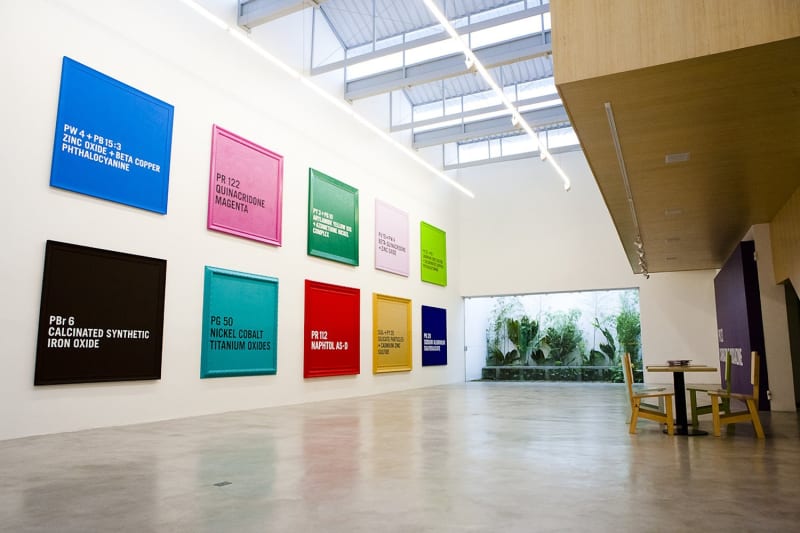Boiling point
PB29. The ultramarine blue that invokes Yves Klein's emblematic color receives a title that throws the color into an aseptic impersonality. However, to subvert something that is apprehended a priori is one of the accomplishments of the work by RAG, an artist who will have his first solo show at Zipper.
The International Klein Blue, copyrighted by the brilliant French artist in May 19, 1960, at the National Institute of Industrial Property, with the identification number 63471, is the most mediatic information one remembers about the great artist who was born in Nice, in 1928, and who died untimely, in 1962. Nowadays, when an artist uses a blue similar to Klein's, he is inevitably linked to Klein.
Fifty years later in São Paulo, Ricardo Aguiar, known as RAG, uses that shade of blue as one of the key-colors of the series of 32 canvases he has systematically produced in his studio located in the neighborhood of Pinheiros. PB29 is part of the sophisticated series presented by Zipper.
The titles of the paintings combine the scientific name and the universal code of the pigment used in the work. Thus, elements from the periodic table of the elements, such as Si (Silicon) and Br (Bromine), appear on the surface of the painting, as well as more complex combinations, such as Dihydroxyanthraquinone – on a semantic level at least. Everything appears in English, as written in the paint tubes the artist buys. The design of the letters also exhales rationalism, accuracy.
"Art ceased to be [...] a kind of inspiration that flows from an unknown fountain, advancing randomly and expressing the picturesque and exterior side of things. Art comes from logic and reason, complemented by genius, but obeying mandates of necessity, and informed by superior laws”, wrote Klein in his journal in 1958. The pair imagination/logic presented by the French artist suits and can be transposed to an analysis of RAG's work.
Influenced by contemporary names such as Damien Hirst – who, in his exhibition at the London gallery Paul Stolper, in 2005, has stressed that science, for many, is the new religion –, RAG creates duos for the dance of science and art. He selects a great amount of color variations, several of them produced artificially, takes the traditional support of art history, painting (on canvas), and keeps working on the traditional surface. But, when he writes the ID of each piece, something much less rigid starts to happen. What was announced impersonally, the chemical formulae and its name, is traced by hand by the artist. RAG, thus, plays with and scrambles concepts such as simulacra and gesture. The choice of frame also follows the intuition of the artist. RAG frames his paintings using extremely subjective methods. He has even ordered the frame for one of the pieces of this series from an old artisan. Rococo edges, barely modernist frames, some neutral, some less decorative, everything is used by the artist.
RAG creates poetry through dealing with the planned and the uncontrollable. Goethe, in his Color Theory, had already stated that color is something larger than scientific laws defend, and RAG draws on this extended perception of color to question identity through art. This same question is proposed by several painters in the contemporary scene. RAG approaches, for example, the pictorial and specular game one sees in the recent works by Luiz Zerbini and Hugo Houayek, specially in the canvas where RAG applies a silver hue. The duality that comes from the confrontation between being and object, real and reflected, material and representation, among other situations, interest the artist from São Paulo.
"We are just physical systems. We are just complex arrangements of carbon molecules. We are mostly water, and our behavior is not going to be an exception to basic physical laws. So it begins to look like whether it is God setting things up in advance and knowing everything you are going to do or whether it's these basic physical laws governing everything, there is not a lot of room left for freedom", complains one of the characters of Waking Life, a disturbing animation by Richard Linklater. "Should our freedom just be a matter of probabilities, just some random swerving in a chaotic system? That just seems like it's worse. I would rather be a gear in a big deterministic, physical machine than just some random swerving", continues the character.
Thus in the space "between" determinacy and instability, RAG produces his work calmly. In these interstices, the artist continues to repeat, through painting, questions familiar to men from other eras. "It is easy to perceive that the value of a given color is emphasized by a certain shape and subdued by another one [...] The number of colors and shapes are infinite. What to say about their combinations and effects? This subject is inexhaustible", highlights Kandinsky in his important On the Spiritual in Art. RAG is starting his career diving in full uncertainties. And he is already starting to produce serigraphs and to plan a sculptural series in which he will investigate the most fashionable market of vanities, that of the "aesthetic" surgeries. RAG's work has everything to be uncomfortable, and for that reason, necessary.
Mario Gioia

